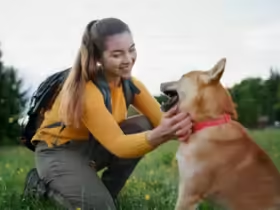Traveling with pets can be an exciting adventure, but it also comes with its challenges. Whether you’re planning a road trip, flying, or heading to a pet-friendly vacation spot, it’s essential to prepare properly to ensure a stress-free journey for both you and your furry companion. This guide will provide detailed tips, practical advice, and important considerations to help make your travel experience with pets as smooth as possible.
1. Prepare Your Pet for Travel
Before embarking on a trip, it’s important to ensure your pet is ready for the journey.
Gradual Acclimatization
If your pet is new to traveling, gradually introduce them to the process. Start with short car rides to help them get used to the motion and environment. You can extend the length of the trips over time to build their comfort level.
Crate or Carrier Training
For many pets, especially cats and smaller dogs, traveling in a crate or carrier is the safest and most secure option. Make sure your pet is comfortable in their carrier by allowing them to spend time in it before your trip. Place treats, toys, and familiar bedding inside to create a positive association.
- Tip: Choose a crate that’s large enough for your pet to stand, turn around, and lie down comfortably. Ensure it’s well-ventilated and secure.
Health Check-Up
Before any long trip, schedule a visit to the vet to ensure your pet is healthy and up-to-date on vaccinations. Discuss the trip with your vet, especially if your pet is prone to anxiety, motion sickness, or any health concerns. They might recommend anti-anxiety medications or natural remedies to ease travel stress.
Microchip and Identification
Ensure your pet’s microchip information is current, and they are wearing a collar with a visible ID tag. In the event your pet gets lost during your travels, this increases the likelihood of a safe return.
2. Plan Your Travel Route and Accommodations
A well-planned route and pet-friendly accommodations can make a big difference in how smoothly your trip goes.
Pet-Friendly Stops
When traveling by car, plan for frequent stops, especially on long trips. Pets need breaks to stretch, relieve themselves, and hydrate. Rest areas or designated pet stops are ideal for allowing your pet some time outside the vehicle.
- Tip: If you’re flying with a pet, confirm layover times that allow for sufficient bathroom breaks in pet relief areas within the airport.
Pet-Friendly Hotels and Rentals
Not all accommodations are pet-friendly, so it’s important to research and book pet-friendly hotels or vacation rentals in advance. Websites like BringFido and Airbnb offer filters for pet-friendly options. Be sure to review any additional fees or restrictions, such as breed or weight limits.
Check Airline Policies for Pet Travel
If you’re flying with your pet, each airline has its own set of policies regarding pet travel. These policies vary in terms of the type of pets allowed, carrier requirements, fees, and whether your pet can travel in-cabin or must go in cargo. Confirm all details well before your departure to avoid last-minute surprises.
3. Packing Essentials for Your Pet
Packing the right items for your pet can make the journey more comfortable and reduce stress for both of you. Here’s a checklist of essential items:
Food and Water
Bring enough of your pet’s regular food to last the entire trip. Changing their diet while traveling can lead to upset stomachs or digestive issues, which is the last thing you want on the road. Pack portable food and water bowls, and ensure you have access to fresh water throughout the journey.
- Tip: Pack extra food in case of delays, and don’t forget to include treats to reward good behavior!
Comfort Items
Your pet’s favorite blanket, toy, or bed can offer comfort during travel. These familiar items provide a sense of security, especially in unfamiliar environments.
Waste Disposal Supplies
For dogs, bring plenty of waste bags for bathroom breaks. For cats, a portable litter box and litter are essential, especially if you’ll be in the car or staying in a hotel.
Health and Safety Items
- Medication: If your pet requires medication, be sure to pack enough for the trip, along with a copy of their prescription.
- First Aid Kit: Pack a pet-specific first aid kit with items like bandages, tweezers, antiseptic wipes, and any emergency care supplies.
- Collar and Leash: Always keep your pet on a leash in public places. Even if your pet is usually calm, new environments can be overwhelming, and a leash ensures their safety.
4. Travel Safety Tips
Keeping your pet safe while traveling is of utmost importance. Here are some tips to ensure their safety during the journey:
Car Travel Safety
- Use a Pet Restraint: In the car, use a pet seatbelt harness, carrier, or crate to secure your pet. Unrestrained pets can become projectiles in case of an accident, posing a danger to both the pet and passengers.
- Don’t Let Your Pet Roam Free: While it might be tempting to let your pet sit in your lap or roam the car, this is unsafe. A sudden stop or swerve can injure them or cause distractions.
- Never Leave Your Pet Alone in the Car: Temperatures inside cars can rise or fall to dangerous levels quickly, even with the windows cracked. Never leave your pet alone in a parked car, regardless of the weather.
Air Travel Safety
- Choose the Right Carrier: Airlines have specific requirements for in-cabin pet carriers, which must fit under the seat in front of you. Make sure the carrier is the right size for your pet and meets the airline’s requirements.
- Fly Direct: Whenever possible, book a direct flight to minimize stress and the time your pet spends in a carrier. Layovers and additional travel time can be overwhelming for pets.
5. Keeping Your Pet Calm During Travel
Travel can be a stressful experience for pets, especially if they’re not accustomed to it. Here are some strategies to help keep them calm:
Exercise Before Travel
Before hitting the road or heading to the airport, make sure your pet gets plenty of exercise. A tired pet is more likely to rest and remain calm during travel.
Natural Calming Aids
There are several natural remedies that can help reduce anxiety in pets, such as:
- Pheromone Sprays: Products like Adaptil (for dogs) or Feliway (for cats) release calming pheromones that mimic those naturally produced by animals.
- Calming Treats: These often contain ingredients like chamomile, valerian root, or L-theanine, which promote relaxation.
- Comfortable Crate Setup: Line your pet’s crate with their favorite blanket and include a familiar toy to create a calming environment.
Distraction and Entertainment
For dogs, chew toys or interactive toys can provide distraction and entertainment during long journeys. Cats may appreciate a soft toy or a familiar item with your scent on it.
- Tip: Consider bringing a puzzle toy that dispenses treats to keep your pet mentally engaged and reduce travel-related anxiety.
6. Upon Arrival: Settling In with Your Pet
Once you arrive at your destination, helping your pet adjust to the new environment is important to minimize stress.
Establish a Routine
Pets thrive on routine. Once you’ve arrived at your hotel or rental, establish a feeding, bathroom, and sleep schedule similar to what your pet is used to at home. This consistency will help them feel more comfortable in a new place.
Explore the Area Gradually
Give your pet time to explore the new space at their own pace. For dogs, start with a brief walk around the area to familiarize them with their surroundings. For cats, let them acclimate to one room at a time before introducing them to the entire space.
Monitor for Signs of Stress
Even well-adjusted pets can experience stress in a new environment. Watch for signs such as excessive panting, pacing, hiding, or loss of appetite. If your pet seems overly stressed, consider using calming aids or offering extra comfort with familiar items from home.
7. Know Local Pet Laws and Regulations
Before traveling, research local pet laws and regulations, especially if you’re going to another country or region. These might include:
- Leash Laws: Many places require pets to be on a leash in public spaces.
- Breed Restrictions: Some hotels, parks, or countries may have breed restrictions, especially for certain types of dogs.
- Vaccination and Health Requirements: Check that your pet’s vaccinations are up to date and whether additional documentation or health certificates are required.
Conclusion
Traveling with pets can be a rewarding experience with the right preparation. By planning ahead, packing the essentials, and taking steps to ensure your pet’s comfort and safety, you can enjoy a stress-free trip with your furry friend. Whether you’re embarking on a road trip or jetting off to a new destination, the key to successful pet travel is patience, organization, and a bit of extra care.
With these tips, both you and your pet can look forward to a memorable and enjoyable adventure together!










Leave a Reply